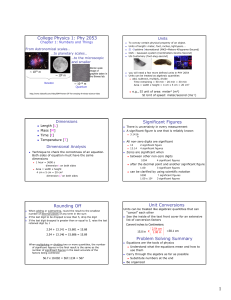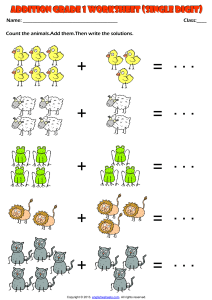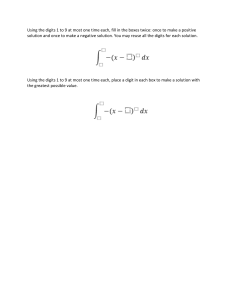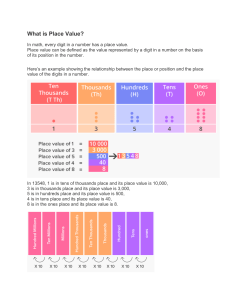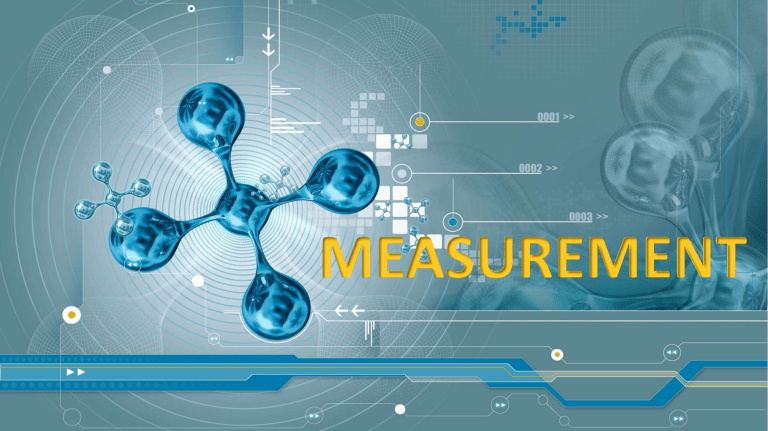
MEASUREMENT Measurement in everyday life Measurement of mass Measurement of volume Measurement in everyday life Measurement of length Measurement of temperature Need for measurement in physics • To understand any phenomenon in physics we have to perform experiments. • Experiments require measurements, and we measure several physical properties like length, mass, time, temperature, pressure etc. • Experimental verification of laws & theories also needs measurement of physical properties. Physical Quantity A physical property that can be measured and described by a number is called physical quantity. Examples: • Mass of a person is 65 kg. • Length of a table is 3 m. • Area of a hall is 100 m2. • Temperature of a room is 300 K Types of physical quantities 1. Fundamental quantities: The physical quantities which do not depend on any other physical quantities for their measurements are known as fundamental quantities. Examples: • Mass • Length • Time • Temperature Types of physical quantities 2. Derived quantities: The physical quantities which depend on one or more fundamental quantities for their measurements are known as derived quantities. Examples: • Area • Volume • Speed • Force Units for measurement The standard used for the measurement of a physical quantity is called a unit. Examples: • metre, foot, inch for length • kilogram, pound for mass • second, minute, hour for time • fahrenheit, kelvin for temperature Characteristics of units Well – defined Suitable size Reproducible Invariable Indestructible Internationally acceptable CGS system of units • This system was first introduced in France. • It is also known as Gaussian system of units. • It is based on centimeter, gram and second as the fundamental units of length, mass and time. MKS system of units • This system was also introduced in France. • It is also known as French system of units. • It is based on meter, kilogram and second as the fundamental units of length, mass and time. FPS system of units • This system was introduced in Britain. • It is also known as British system of units. • It is based on foot, pound and second as the fundamental units of length, mass and time. International System of units (SI) • In 1971, General Conference on Weight and Measures held its meeting and decided a system of units for international usage. • This system is called international system of units and abbreviated as SI from its French name. • The SI unit consists of seven fundamental units and two supplementary units. Seven fundamental units FUNDAMENTAL QUANTITY SI UNIT SYMBOL Length metre m Mass kilogram kg Time second s Temperature kelvin K Electric current ampere A Luminous intensity candela cd Amount of substance mole mol Definition of metre The metre is the length of the path travelled by light in a vacuum during a time interval of 1/29,97,92,458 of a second. Definition of kilogram The kilogram is the mass of prototype cylinder of platinum-iridium alloy preserved at the International Bureau of Weights and Measures, at Sevres, near Paris. Prototype cylinder of platinum-iridium alloy Definition of second One second is the time taken by 9,19,26,31,770 oscillations of the light emitted by a cesium–133 atom. Two supplementary units 1. Radian: It is used to measure plane angle θ = 1 radian Two supplementary units 2. Steradian: It is used to measure solid angle Ω = 1 steradian Rules for writing SI units 1 Full name of unit always starts with small letter even if named after a person. • newton • ampere • coulomb • Newton not • Ampere • Coulomb Rules for writing SI units 2 Symbol for unit named after a scientist should be in capital letter. • N for newton • A for ampere • K for kelvin • C for coulomb Rules for writing SI units 3 Symbols for all other units are written in small letters. • m for meter • kg for kilogram • s for second • cd for candela Rules for writing SI units 4 One space is left between the last digit of numeral and the symbol of a unit. • 10 kg • 5N • 15 m • 10kg not • 5N • 15m Rules for writing SI units 5 The units do not have plural forms. • 6 metre • 6 metres • 14 kg • 14 kgs • 20 second • 18 kelvin not • 20 seconds • 18 kelvins Rules for writing SI units 6 Full stop should not be used after the units. • 7 metre • 12 N • 25 kg • 7 metre. not • 12 N. • 25 kg. Rules for writing SI units 7 No space is used between the symbols for units. • 4 Js • 19 Nm • 25 VA • 4Js not • 19 N m. • 25 V A. SI prefixes Factor 10 Name Symbol 24 yotta Y 10 21 zetta Z 10 18 exa E 10 15 peta P 10 12 tera T 10 9 giga G 10 6 mega M 10 3 kilo k 10 2 hecto h 10 1 deka da 10 10 10 10 10 10 10 10 10 10 Factor Name Symbol −1 deci d −2 centi c −3 milli m −6 micro μ −9 nano n −12 pico p −15 femto f −18 atto a −21 zepto z −24 yocto y Use of SI prefixes • 3 milliampere = 3 mA = 3 x 10 • 5 microvolt = 5 μV = 5 x 10 −6 • 8 nanosecond = 8 ns = 8 x 10 • 6 picometre = 6 pm = 6 x 10 −3 A V −9 −12 s m 3 • 5 kilometre = 5 km = 5 x 10 m 6 • 7 megawatt = 7 MW = 7 x 10 W Some practical units for measuring length 1 micron = 10 −6 Bacterias m 1 nanometer = 10 Molecules −9 m Some practical units for measuring length 1 angstrom = 10 Atoms −10 m 1 fermi = 10 −15 Nucleus m Some practical units for measuring length • Astronomical unit = It is defined as the mean distance of the earth from the sun. 11 • 1 astronomical unit = 1.5 x 10 m Distance of planets Some practical units for measuring length • Light year = It is the distance travelled by light in vacuum in one year. 15 • 1 light year = 9.5 x 10 m Distance of stars Some practical units for measuring length • Parsec = It is defined as the distance at which an arc of 1 AU subtends an angle of 1’’. • It is the largest practical unit of distance used in astronomy. 16 • 1 parsec = 3.1 x 10 m 1 AU 1” Some practical units for measuring area • Acre = It is used to measure large areas in British system of units. 1 acre = 208’ 8.5” x 208’ 8.5” = 4046.8 m2 • Hectare = It is used to measure large areas in French system of units. 1 hectare = 100 m x 100 m = 10000 m2 • Barn = It is used to measure very small areas, such as nuclear cross sections. −28 1 barn = 10 m2 Some practical units for measuring mass 1 metric ton = 1000 kg 1 quintal = 100 kg Steel bars Grains Some practical units for measuring mass 1 pound = 0.454 kg 1 slug = 14.59 kg Newborn babies Crops Some practical units for measuring mass • 1 Chandrasekhar limit = 1.4 x mass of sun = 2.785 x 10 • It is the biggest practical unit for measuring mass. Massive black holes 30 kg Some practical units for measuring mass 1 • 1 atomic mass unit = x mass of single C atom 12 −27 • 1 atomic mass unit = 1.66 x 10 kg • It is the smallest practical unit for measuring mass. • It is used to measure mass of single atoms, proton and neutron. Some practical units for measuring time • 1 Solar day = 24 h • 1 Sidereal day = 23 h & 56 min • 1 Solar year = 365 solar day = 366 sidereal day • 1 Lunar month = 27.3 Solar day −8 • 1 shake = 10 s Seven dimensions of the world Fundamental quantities Dimensions Length Mass Time Temperature Current Amount of substance Luminous intensity [L] [M] [T] [K] [A] [N] [J] Dimensions of a physical quantity The powers of fundamental quantities in a derived quantity are called dimensions of that quantity. Dimensions of a physical quantity Example: Mass Density = Volume Mass = length × breath × height [M] [M] [Density] = = 3 = [ML−3 ] L × L × L L Hence the dimensions of density are 1 in mass and − 3 in length. Uses of Dimension To check the correctness of equation To convert units To derive a formula To check the correctness of equation Consider the equation of displacement, 1 2 ∆x = vi t + a t 2 By writing the dimensions we get, ∆x = displacement = [L] length vi t = velocity × time = × time = [L] time at 2 = acceleration × time2 length 2 = [L] = × time time2 The dimensions of each term are same, hence the equation is dimensionally correct. To convert units Let us convert newton SI unit of force into dyne CGS unit of force . The dimesions of force are = [LMT −2 ] So, and, Thus, 1 newton = (1 m)(1 kg)(1 s)−2 1 dyne = (1 cm)(1 g)(1 s)−2 1 newton 1m = 1 dyne 1 cm 1 kg 1g 1s 1s = 100 × 1000 = 105 Therefore, 1 newton = 105 dyne −2 100 cm = 1 cm 1000 g 1g 1s 1s −2 To derive a formula The time period ‘T’ of oscillation of a simple pendulum depends on length ‘l’ and acceleration due to gravity ‘g’. Thus, L0 M 0 T1 = K [L1 M0 T 0 ]a [L1 M0 T −2 ]b = K La M 0 T 0 Let us assume that, T ∝ 𝑙 a 𝑔b L0 M0 T1 = K La+b M 0 T −2b or T = K 𝑙 a 𝑔b a+b=0 K = constant which is dimensionless Dimensions of T = [L0 M0 T1 ] ∴ 1 b=− 2 0 0 [L1 M 0 T −2 ] & − 2b = 1 & 1 a= 2 T = K 𝑙1/2 𝑔−1/2 Dimensions of 𝑙 = [L M T ] 1 Dimensions of g = Lb M 0 T −2b ∴ T=K 𝑙 𝑔 Least count of instruments The smallest value that can be measured by the measuring instrument is called its least count or resolution. LC of length measuring instruments Ruler scale Vernier Calliper Least count = 1 mm Least count = 0.1 mm LC of length measuring instruments Screw Gauge Spherometer Least count = 0.01 mm Least count = 0.001 mm LC of mass measuring instruments Weighing scale Electronic balance Least count = 1 kg Least count = 1 g LC of time measuring instruments Wrist watch Stopwatch Least count = 1 s Least count = 0.01 s Accuracy of measurement It refers to the closeness of a measurement to the true value of the physical quantity. Example: • True value of mass = 25.67 kg • Mass measured by student A = 25.61 kg • Mass measured by student B = 25.65 kg • The measurement made by student B is more accurate. Precision of measurement It refers to the limit to which a physical quantity is measured. Example: • Time measured by student A = 3.6 s • Time measured by student B = 3.69 s • Time measured by student C = 3.695 s • The measurement made by student C is most precise. Significant figures The total number of digits (reliable digits + last uncertain digit) which are directly obtained from a particular measurement are called significant figures. Significant figures Mass = 6.11 g Speed = 67 km/h 3 significant figures 2 significant figures Significant figures Time = 12.76 s Length = 1.8 cm 4 significant figures 2 significant figures Rules for counting significant figures 1 All non-zero digits are significant. Number Significant figures 16 2 35.6 3 6438 4 Rules for counting significant figures 2 Zeros between non-zero digits are significant. Number Significant figures 205 3 3008 4 60.005 5 Rules for counting significant figures 3 Terminal zeros in a number without decimal are not significant unless specified by a least count. Number Significant figures 400 1 3050 3 (20 ± 1) s 2 Rules for counting significant figures 4 Terminal zeros that are also to the right of a decimal point in a number are significant. Number Significant figures 64.00 4 3.60 3 25.060 5 Rules for counting significant figures 5 If the number is less than 1, all zeroes before the first non-zero digit are not significant. Number Significant figures 0.0064 2 0.0850 3 0.0002050 4 Rules for counting significant figures 6 During conversion of units use powers of 10 to avoid confusion. Number Significant figures 2.700 m 2 2.700 x 10 cm −3 2.700 x 10 km 4 4 4 Exact numbers • Exact numbers are either defined numbers or the result of a count. • They have infinite number of significant figures because they are reliable. By definition By counting 1 dozen = 12 objects 45 students 1 hour = 60 minute 5 apples 1 inch = 2.54 cm 6 faces of cube Rules for rounding off a measurement 1 If the digit to be dropped is less than 5, then the preceding digit is left unchanged. Number Round off up to 3 digits 64.62 64.6 3.651 3.65 546.3 546 Rules for rounding off a measurement 2 If the digit to be dropped is more than 5, then the preceding digit is raised by one. Number Round off up to 3 digits 3.479 3.48 93.46 93.5 683.7 684 Rules for rounding off a measurement 3 If the digit to be dropped is 5 followed by digits other than zero, then the preceding digit is raised by one. Number Round off up to 3 digits 62.354 62.4 9.6552 9.66 589.51 590 Rules for rounding off a measurement 4 If the digit to be dropped is 5 followed by zero or nothing, the last remaining digit is increased by 1 if it is odd, but left as it is if even. Number Round off up to 3 digits 53.350 53.4 9.455 9.46 782.5 782 Significant figures in calculations Addition & subtraction The final result would round to the same decimal place as the least precise number. Example: • 13.2 + 34.654 + 59.53 = 107.384 = 107.4 • 19 – 1.567 - 14.6 = 2.833 = 3 Significant figures in calculations Multiplication & division The final result would round to the same number of significant digits as the least accurate number. Example: • 1.5 x 3.67 x 2.986 = 16.4379 = 16 • 6.579/4.56 = 1.508 = 1.51 Errors in measurement Difference between the actual value of a quantity and the value obtained by a measurement is called an error. Error = actual value – measured value Types of errors Systematic errors Gross errors Random errors 1. Systematic errors • These errors are arise due to flaws in experimental system. • The system involves observer, measuring instrument and the environment. • These errors are eliminated by detecting the source of the error. Types of systematic errors Personal errors Instrumental errors Environmental errors a. Personal errors These errors are arise due to faulty procedures adopted by the person making measurements. Parallax error b. Instrumental errors These errors are arise due to faulty construction of instruments. Zero error c. Environmental errors These errors are caused by external conditions like pressure, temperature, magnetic field, wind etc. Following are the steps that one must follow in order to eliminate the environmental errors: a. Try to maintain the temperature and humidity of the laboratory constant by making some arrangements. b. Ensure that there should not be any external magnetic or electric field around the instrument. Advanced experimental setups 2. Gross errors These errors are caused by mistake in using instruments, recording data and calculating results. Example: a. A person may read a pressure gauge indicating 1.01 Pa as 1.10 Pa. b. By mistake a person make use of an ordinary electronic scale having poor sensitivity to measure very low masses. Careful reading and recording of the data can reduce the gross errors to a great extent. 3. Random errors • These errors are due to unknown causes and are sometimes termed as chance errors. • Due to unknown causes, they cannot be eliminated. • They can only be reduced and the error can be estimated by using some statistical operations. Error analysis For example, suppose you measure the oscillation period of a pendulum with a stopwatch five times. Trial no ( i ) Measured value ( Xi ) 1 2 3 4 5 3.9 3.5 3.6 3.7 3.5 Mean value The average of all the five readings gives the most probable value for time period. 1 X= n Xi 3.9 + 3.5 + 3.6 + 3.7 + 3.5 18.2 X= = 5 5 X = 3.64 = 3.6 Absolute error The magnitude of the difference between mean value and each individual value is called absolute error. ∆Xi = X − Xi The absolute error in each individual reading: Xi ∆Xi 3.9 3.5 3.6 3.7 3.5 0.3 0.1 0 0.1 0.1 Mean absolute error The arithmetic mean of all the absolute errors is called mean absolute error. 1 ∆X = n ∆Xi 0.3 + 0.1 + 0 + 0.1 + 0.1 0.6 ∆X = = 5 5 ∆X = 0.12 = 0.1 Reporting of result • The most common way adopted by scientist and engineers to report a result is: Result = best estimate ± error • It represent a range of values and from that we expect a true value fall within. • Thus, the period of oscillation is likely to be within (3.6 ± 0.1) s. Relative error The relative error is defined as the ratio of the mean absolute error to the mean value. relative error = ∆X / X 0.1 ∆X / X = = 0.0277 3.6 ∆X / X = 0.028 Percentage error The relative error multiplied by 100 is called as percentage error. percentage error = relative error x 100 percentage error = 0.028 x 100 percentage error = 2.8 % Least count error Least count error is the error associated with the resolution of the instrument. • The least count error of any instrument is equal to its resolution. • Thus, the length of pen is likely to be within (4.7 ± 0.1) cm. Combination of errors In different mathematical operations like addition, subtraction, multiplication and division the errors are combined according to some rules. • Let ∆A be absolute error in measurement of A • Let ∆B be absolute error in measurement of B • Let ∆X be absolute error in measurement of X When X = A ± B ∆X X = ∆A+∆B A±B ∆X = ∆A + ∆B When X = A × B or A / B ∆X X ∆X = = ∆A A ∆A A + + ∆B B ∆B X B n When X = A ∆X X = ∆A n A ∆A ∆X = n X A Estimation Estimation is a rough calculation to find an approximate value of something that is useful for some purpose. Estimate the number of flats in Dubai city Estimate the volume of water stored in a dam Order of magnitude The approximate size of something expressed in powers of 10 is called order of magnitude. To get an approximate idea of the number, one may round the coefficient a to 1 if it is less than or equal to 5 and to 10 if it is greater than 5. Examples: −31 • Mass of electron = 9.1 x 10 kg −31 −30 ≈ 10 x 10 kg ≈ 10 kg 53 • Mass of observable universe = 1.59 x 10 kg ≈ 1 x 10 53 53 kg ≈ 10 kg Thank You

